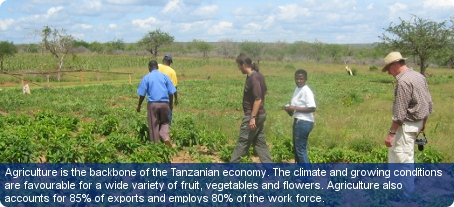Find a business in United Republic of Tanzania

Discoveries of natural gas from the island of Songo Songo and an increase in gold mining activity in Tanzania caused real growth in GDP to soar in the 2000s – 6.9% per annum (2006-10). Despite the adverse global economic conditions of 2008-09, the Tanzanian economy continued to grow and strengthen. However, Tanzania still remains one of the least-developed countries in the world with a GNI per capita of US$530.
The agriculture, forestry and fisheries sector contributes 29% of GDP and about 80% of the labour force is engaged in agriculture, mainly on a small scale. The most important cash crops for smallholders are cotton, coffee, tobacco and cashew nuts. There is huge unexploited potential for fisheries – both in the sea and the larger lakes – and for fish farming throughout the country. But the industry is still relatively under-developed. Tuna and shellfish are important in marine fisheries and Nile perch and freshwater sardines in the major lakes.
Large reserves of natural gas have been found off the coast of southern Tanzania, notably in the Songo Songo field, and there are good indications of oil deposits though these are yet to be proven. There are 6.513 billion cubic metres of proven natural gas reserves (January, 2011) and this industry, along with gold mining, is a vital part of Tanzania’s economy.
Mining production has grown strongly during the 2000s, though mining still only contributes about 3% of GDP. Gold-mining has shown the strongest growth and the industry sector as a whole contributes 23% of GDP (2010). Other important minerals include diamonds and gemstones, particularly tanzanite. Deposits of coal, uranium, nickel and platinum are also present in the country.
Tanzania is in the unfortunate position of having topographic and climatic conditions which limit the cultivation of crops to only 4% of the land area. This is a very difficult situation in a country which depends on agriculture. This situation should be viewed against the background of recent Tanzanian history. When the country attained its independence in 1961 it did so with a severely underdeveloped economy and extremely limited infrastructure.
The World Bank, the IMF and bilateral donors have provided funds to rehabilitate Tanzania’s out-of-date economic infrastructure and to alleviate poverty. Long-term growth through 2005 featured a pickup in industrial production and a substantial increase in output of minerals led by gold. Recent banking reforms have helped increase private-sector growth and investment. Continued donor assistance and solid macroeconomic policies supported real GDP growth of nearly 6% in 2006.
Around 9% of the 79,000-km road network is paved. One railway system links Dar es Salaam, the most important port, with the interior to the west and north, and the other, the narrow-gauge Tanzara Railway, runs from Dar es Salaam to Zambia in the south-west. The international airports are at Dar es Salaam, Kilimanjaro and Zanzibar.
Tanzania is ranked 36th in the world for enforcing contracts, according to the World Bank’s ‘Doing Business 2012’ study of 183 countres. It is 14th in the sub-Saharan regional rankings for ease of doing business. These rankings measure the conduciveness of a regulatory regime in starting and operating a business.
Tanzania has a 77% literacy rate among people aged 15-24 and English is generally used in professional and business life, while Kiswahili is universally understood.







